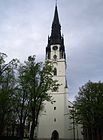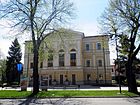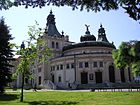Spišská Nová Ves
| Spišská Nová Ves | ||
|---|---|---|
| coat of arms | map | |

|
|
|
| Basic data | ||
| State : | Slovakia | |
| Kraj : | Košický kraj | |
| Okres : | Spišská Nová Ves | |
| Region : | Spiš | |
| Area : | 66.671 km² | |
| Residents : | 37,007 (Dec. 31, 2019) | |
| Population density : | 555 inhabitants per km² | |
| Height : | 430 m nm | |
| Postal code : | 052 01 | |
| Telephone code : | 0 53 | |
| Geographic location : | 48 ° 57 ' N , 20 ° 34' E | |
| License plate : | SN | |
| Kód obce : | 526355 | |
| structure | ||
| Community type : | city | |
| Urban area structure: | 2 districts | |
| Administration (as of November 2018) | ||
| Mayor : | Pavol Bečarik | |
| Address: | Mestský úrad Spišská Nová Ves Radničné námestie 7 052 80 Spišská Nová Ves |
|
| Website: | www.spisskanovaves.eu | |
| Statistics information on statistics.sk | ||
Spišská Nová Ves (German (Zipser) Neu (en) village, Hungarian Igló ) is one of the largest cities in Eastern Slovakia , southeast of the High Tatras and is located in the traditional region of Spiš . The city is the capital of the district of the same name .
The Spiš Castle and the Slovak Paradise National Park are well-known attractions in the area .
history
The city is an old settlement area ( Neolithic , Great Moravia ). In the 12th century at the latest, the Slovak settlement Iglov stood on the site of today's town . In the 13th century, German settlers (so-called Zipser Saxons ) founded the village of Neudorf in their immediate vicinity . In the 2nd half of the 13th century both settlements merged. The German majority was replaced by a Slovak majority in the 19th century.
In the 14th century, the settlement developed into an important town with market rights. It has been an official mining town since 1380. The city had the largest street market in Slovakia. She was a member of the brotherhood of the 24 royal pastors, the union of the 24 Spis cities, was among the 13 cities pledged to Poland in the years 1412–1772 and since 1778 the capital of the province of the 16 Spis cities (for details see Spiš ).
In 2017 Spišská Nová Ves was awarded the honorary title of “ Reformation City of Europe ” by the Community of Evangelical Churches in Europe .
Population development
| Ethnic structure | ||||||||
|---|---|---|---|---|---|---|---|---|
| year | Residents | Slovaks | German | Hungary | Others | |||
| 1880 | 7,521 | 4,338 | 2,249 | 569 | - | |||
| 1890 | 7,345 | 4.214 | 2,300 | 786 | - | |||
| 1900 | 9,301 | 4,966 | 2,042 | 2,220 | - | |||
| 1910 | 10,525 | 5,103 | 1,786 | 3,494 | - | |||
| 1921 | 11,608 | 7,735 | - | 1,089 | - | |||
| 1930 | 12,965 | 10.094 | 1,461 | 619 | - | |||
| 1991 | 39,218 | 37,638 | 57 | 79 | - | |||
| 2001 | 39.193 | 36,924 | 74 | 65 | - | |||
| 2011 | 38,045 | 33,656 | 52 | 54 | - | |||
Surname
The original Slovak settlement was called Iglow (translated roughly "Nadelhausen", derived from the narrow form of the settlement). The neighboring German settlement was called Nova Villa (1268, German "Neudorf" - first source evidence ) or Hungarian Igloszasza (1279, German "Saxon Iglow").
After the merger of the two settlements ( Iglow alio nomine Nova Villa was mentioned in 1380 ), the settlement was called both Neudorf and Iglow (later only Iglovia ) in some Latin documents in the 15th century , and in Hungarian documents the form Igló, derived from Iglov, was used through, in German the form Newendorf (later Neudorf, later also Zipser Neudorf ). A translation of the German name has been used in Slovak texts since the 18th century at the latest (1786 Nowa Wes, German "Neudorf"; since 1920 Spišská Nová Ves, German "Zipser Neudorf").
City structure
The city is divided into two districts:
- Novoveská Huta ( front huts )
- Spišská Nová Ves with the districts of Centrum ("Center"), Sídlisko Západ ("Settlement West"), Sídlisko Východ ("Settlement East"), Sídlisko Tarča, Sídlisko Mier ("Peace Settlement") and Ferčekovce
Attractions
The city center is characterized by a large, spindle-shaped long square on which the most important sights are located:
- the Roman Catholic parish church of the Assumption of the Virgin Mary from the 14th century, whose tower, built in the 19th century with a height of 87 meters, is the highest church tower in Slovakia
- the Protestant Tolerance Church from the end of the 18th century
- the classical town hall
- the redoubt , built around 1900, which today houses the Spiš Theater
Sports
Town twinning
Sister towns of Spišská Nová Ves are
|
sons and daughters of the town
- Robert Arató (* 1959), visual artist
- Martin Bakoš (* 1990), ice hockey player
- Jozef Dolný (* 1992), football player
- Mikuláš Huba (1919–1986), actor
- Július Hudáček (* 1988), ice hockey goalkeeper
- Stanislav Jasečko (* 1972), ice hockey player
- Ladislav Karabin (* 1970), Slovak-American ice hockey player
- Christoph Klesch (1632–1706), Protestant theologian and poet
- Daniel Klesch (1624–1697), Lutheran theologian and poet
- Gottfried Schwarz (1707–1786), German Protestant theologian
- Károly Thern (1817–1886), Hungarian composer
- Richard Trojan (* 1966), Slovak-German ice hockey player
- Ľubomír Vaic (* 1977), Slovak ice hockey player
- Ernest Valko (1953–2010), Slovak lawyer and politician
- Ede Zathureczky (1903–1959), Hungarian violinist and music teacher
See also
Web links
- Spišská Nová Ves In: visitslovakia.com
proof
- ^ Reformation town Spišská Nová Ves. Slovakia. In: reformation-cities.org/cities, accessed September 8, 2017.
- ^ City website - Partnerské mestá. In: spisskanovaves.eu, accessed on May 11, 2017.







